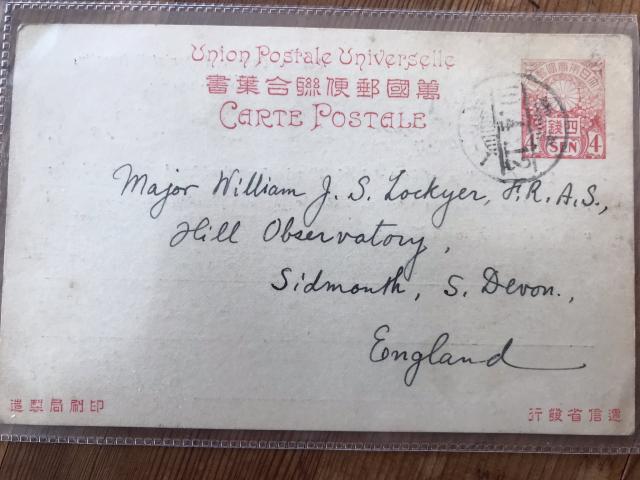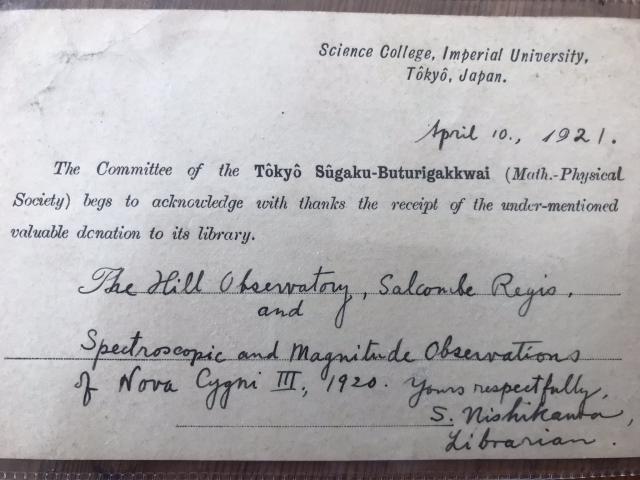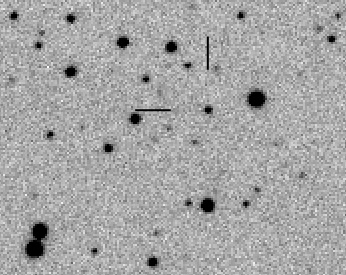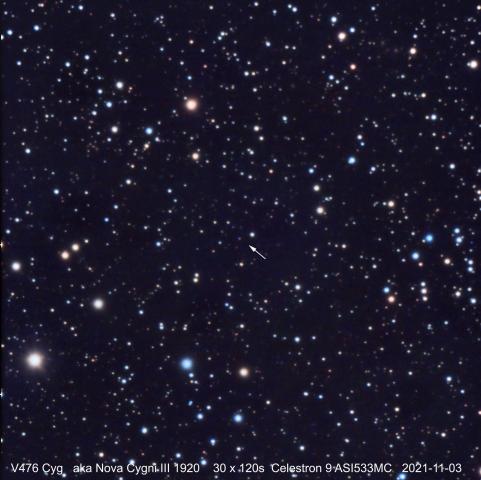- This topic has 3 replies, 2 voices, and was last updated 4 years, 1 month ago by
 David Strange.
David Strange.
-
AuthorPosts
-
21 October 2021 at 1:42 pm #575078
 David StrangeParticipant
David StrangeParticipantThis postcard has finally reached us after a 100 year delay. It was originally sent by S. Nishikawra the librarian of the Science College at the Imperial University, Tokyo, Japan addressed to Jim Lockyer dated 10th April 1921. It acknowledged receipt of Lockyer’s spectroscopic observations of Nova Cygni III 1920 and the Handbook of the Hill Observatory, Salcombe Regis.
Whoever sent it remains a mystery! It arrived in a plastic envelope inside a letter which had a UK first class stamp attached. There was no covering letter or explanation of who had sent it, other than what looks like a UK postcode on the back of the letter which can be traced to Petworth, Sussex.
There are several interesting facts of interest to surface from this tardy delivery!
V476 Cygni or Nova Cygni 1920 was a nova which occurred in the constellation Cygnus in 1920. It was discovered by William Frederick Denning, an English amateur astronomer, at 09:30 GMT on 20 August 1920, at which time it had a magnitude of 3.7. It reached a peak brightness of magnitude 1.7 on 23 August 1920. Its quiescent brightness is magnitude 17.09. (Wikipedia)
V476 Cygni’s light curve is quite unusual, showing a rapid decline from maximum brightness, followed by a slow nearly linear fading. It is classified as a very fast nova, with a very long tail. The light curve shows a “dust dip”, a fast decline to a local brightness minimum, then a small increase in brightness, and finally a long, slow decline. This dust dip is believed to is believed to coincide with the formation of dust in the material ejected from the nova as it moves away from the star and cools
The paper that Jim Lockyer had sent to Japan can be found here:
Further Observations of the Spectrum of Nova Cygni III., 1920. By Major W. J. S. Lockyer, M.A., Ph.D., and D. L. Edwards, D.I.C., A.R.C.S. (Plate 7.)
http://articles.adsabs.harvard.edu/pdf/1921MNRAS..81..173L
“Since the date of our last communication to the Society on the spectrum of this nova, further photographs have been secured. The same instrument was employed, namely, the McClean 12-inch prismatic camera, having a 12-inch prism of 20deg angle.”
Also Lockyer writes an article (Nov. 4th 1920) for Nature here: “The New Star in Cygnus”
The new star in Cygnus, the third discovered in that constellation, and therefore designated Nova Cygni Ill., was of magnitude 3·5 when first observed by Mr. Denning on August 20, but is now very faint, being below 9th magnitude. It is still visible in small telescopes, but requires large instruments for spectroscopic investigation.
https://www.nature.com/articles/106315a0.pdf
The amazing fact about this nova was that Sir Norman Lockyer died just 4 days prior to this nova appearing in the sky on August 16th. James Lockyer made nightly observations of this star throughout September on nearly every night since the skies were remarkably clear. He must have secretly thought that his father was sending a message from the Heavens!
Also note on the postcard that the observatory at that time was still known as the Hill Observatory. It must have been several years after Lockyer’s death that James renamed it the Norman Lockyer Observatory in honour of its founder.
Challenge: Have a go at imaging V476 Cyg and see if you can record the expanding shell of the 100 yr old planetary nebula! RA = 19h58m24s Dec = 53deg37min7s


Attachments:
21 October 2021 at 9:53 pm #584818 Nick JamesParticipant
Nick JamesParticipantDavid – That is a really interesting story. V476 Cyg is sitting at around 18.0 tonight. I think you’d need a pretty big telescope and dark skies to get the shell.
 21 October 2021 at 11:19 pm #584820
21 October 2021 at 11:19 pm #584820 David StrangeParticipant
David StrangeParticipantWow! Thanks for trying!
David 🙂
4 November 2021 at 11:30 am #584884 David StrangeParticipant
David StrangeParticipantHere’s my image of V476 Cyg. One hour’s exposure and no expanding shell visible!
David

-
AuthorPosts
- You must be logged in to reply to this topic.
